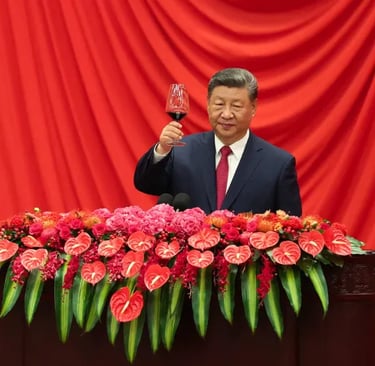China: How New Beijing’s Export Restrictions on Rare Earth Metals Are Changing the Game for Global Business
China's expanded export controls on rare earth elements represent a major geopolitical move, leveraging Beijing's market dominance as retaliation in its technological rivalry with the West. Will this action successfully coerce foreign manufacturers into relocating production to China, or will it accelerate the costly and complex global shift toward a truly independent, diversified supply chain?
CHINA
Ekaterina Romanenko
10/13/20254 min read


On October 9, 2025, China's Ministry of Commerce (MOFCOM) enacted a measure that could fundamentally alter global technology supply chains. Beijing introduced an expanded and significantly stricter export control regime for rare earth elements (REEs), a group of 17 chemical elements critical for the production of nearly all modern electronics, green energy, and defense systems.
The timing and severity of the decision caught many observers by surprise, but the move itself was a clear response to the long-standing technological rivalry with the United States, during which Washington imposed sanctions and restrictions on Chinese companies, primarily in the semiconductor sector. Now, Beijing retaliates by leveraging its main competitive advantage: its dominance in the REE market.
The new rules do not constitute a complete ban but rather a complex licensing system that grants Chinese authorities the power to decide who can access these resources, in what quantities, and for what purposes. The restrictions cover the entire production chain, from ore mining and processing technologies to finished products, particularly permanent magnets, which are key components in electric motors and generators.
The most significant innovation was the application of the extraterritorial principle: any company in the world producing goods with a Chinese REE content of over 0.1% must now obtain an export license from MOFCOM. Furthermore, applications related to the defense industry are subject to automatic rejection, or more precisely, will be approved only in exceptional cases.
The motives for these measures, as stated in the MOFCOM announcement, are that transferring Chinese rare earths and technologies to entities involved in military or "sensitive" areas is assessed as a threat to national security. But Beijing's other objectives are also clear: firstly, the new measures create powerful leverage in negotiations with the West, and secondly, they incentivize foreign manufacturers to relocate their high-tech production to China to ensure guaranteed access to raw materials, aligning with the long-term "Made in China 2025" strategy.
The global economy's dependence on China in this sphere is almost absolute. Beijing controls about 70% of the world's REE mining, but more importantly, it controls nearly 90% of the world's processing and refining capacity. This technologically complex and environmentally hazardous process was willingly outsourced by Western countries years ago, creating the vulnerability that is now being felt worldwide.
The United States faces a dual threat. First, its defense-industrial complex is directly impacted. The production of a single F-35 fighter jet requires about 400 kg of rare earth elements, while an Arleigh Burke-class destroyer needs 2400 kg. The Pentagon is already implementing a strategy to create a supply chain independent of China "Mine-to-Magnet" by 2027, having invested over $439 million in this area since 2020, but this is a long-term project.
Second, the civilian sector will be severely affected, especially the automotive industry during its transition to electric vehicles, as each EV contains 1-2 kg of these metals in its motor. Companies like Tesla, Ford, and General Motors are already facing the prospect of production disruptions. Ford was even forced to temporarily halt production at some of its plants after the April round of restrictions due to a shortage of magnets containing rare earth metals.
The European Union finds itself in an equally difficult position. Its ambitious Green Deal, which relies heavily on wind power generation and electric vehicles, is directly dependent on stable REE supplies. The German auto industry, undergoing a costly transformation, could face rising costs and production delays. The EU's technology leaders, such as lithography equipment manufacturer ASML and aerospace giant Airbus, are also vulnerable as they use REE-based components. Unlike the United States, Europe currently has almost no significant domestic production of rare earths, which exacerbates its dependence.
The European Central Bank has warned of potential inflationary risks for the Eurozone, as a shortage of materials could lead to higher prices for finished goods. In the long term, if the restrictions remain, analysts predict a substantial increase in rare earth metal prices and a 5-10% rise in the cost of final products like electric vehicles and electronics. This poses serious challenges for European automakers like Volkswagen and for global tech giants, including ASML, Apple, and Samsung.
The CIS countries, including Russia, will feel an indirect but significant impact. Local assembly plants for automobiles and home appliances rely on imported components that will now inevitably become more expensive. This will lead to higher consumer prices and could pose risks to localized production. Although Russia has considerable REE reserves, establishing a full-cycle processing and manufacturing capability is a task that requires many years and substantial investment.
Is a strategy of diversification and moving away from Chinese suppliers realistic? In the short term, the answer is likely no. In the long term, however, it is an inevitable but extremely complex and costly process. The main problem is not finding new deposits, as large reserves have already been discovered in Sweden, the US, and Australia, but rather building the processing capacity. The construction of a single such plant is estimated to cost around $1 billion and could take 8 to 15 years, while also requiring solutions to serious environmental issues and a shortage of skilled personnel.
As a result, the world is moving toward a fundamental change in its supply system. One supply chain will remain oriented toward China, offering lower prices but subject to political risks, while another, an allied one, will be more expensive but also more secure. Companies are being forced to revise their strategies, adopting a "China+1" approach, which involves maintaining operations in the PRC while simultaneously developing production sites in other countries like Australia, Vietnam, Canada, or Malaysia.
Furthermore, research into alternative materials and processing technologies is intensifying, including "urban mining", the extraction of rare earth metals from electronic waste. Although less than 1% of these metals are recycled today, the potential of this approach is enormous.
China's decision signals that the era of hyper-globalization, where economic efficiency was the primary criterion, is coming to an end. An era is dawning where the resilience and security of supply chains are becoming just as important as their cost. For global business, a new reality has arrived, one in which geopolitical risks are an integral part of any production strategy.


